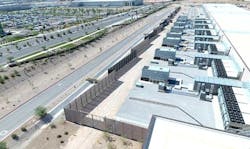A microgrid can operate as part of the electric grid or disconnect from it to provide an independent, temporary power source. They’re increasingly utilized at hospitals, military bases and other facilities that would experience significant disruption if an outage occurred. The benefits of microgrids could also improve how data centers operate. Here’s a look at the advantages they bring.
Transitioning From Energy Consumers to Energy Suppliers
It’s well-known that data centers use a tremendous amount of energy. Microgrids could cause a positive shift by allowing those facilities to become less reliant on the main electricity infrastructure.
Ireland’s electricity regulator recently imposed stricter criteria on entities wanting to build data centers in the country. That was in response to growing concerns that the aggressive new construction of those facilities could make it hard to meet climate goals.
Applicants must meet numerous criteria when applying for permission to build a new data center. According to Data Center Dynamics, one of the potential requirements is that those facilities produce their own power during times of heightened demand. Microgrids can store energy for later use and could help data center operators do that.
Canadian researchers also developed a concept whereby wasted data center energy could feed into direct-current microgrids and a battery storage system to power nearby communities. They want to target the energy expended during data centers’ monthly generator tests. It does not currently support these facilities’ ongoing electricity usage needs, but the group estimated that this new arrangement could result in major changes.
They found that the energy used for an hour’s worth of generator tests in a data center could give a 125-unit housing complex a day’s worth of power. The world collectively generates about 2.5 quintillion bytes of data daily, which will likely rise with time. That societal dependence makes these centers necessary. However, discussions must also occur about making the facilities less energy-intensive, potentially with help from microgrids.
Making Data Centers More Resilient
Data center outages can be extremely costly. One study found that one in six facilities experienced disruptions that cost more than $1 million. During one four-hour power outage at a London data center in January 2021, the affected company’s technology to enable switching over to generator power also failed.
That example shows the importance of having multiple strategies to keep data centers running. One of the benefits of microgrids is that they can become part of the larger resilience strategy.
Amber Caramella, the chief revenue officer at Neutrality Data Centers, said, “The key to uptime begins with a fault-tolerant design that mitigates single points of failure as the foundation of infrastructure.” That’s a good reminder that microgrids are not the all-encompassing solution to data center outages. However, they can be instrumental in helping those facilities prevent catastrophe and ensure they’ve covered all their bases.
Data center decision-makers may find that affordability is another of the most appealing benefits of microgrids. Some companies providing resilience-as-a-service include them within their packages. In such arrangements, clients can often only pay for what they use or agree on other terms that make it easier to budget for a microgrid in a larger resiliency plan.
Providing Better Flexibility for Data Center Utilization
Most people who think of data centers imagine them serving highly populated areas with high tech adoption rates. Such facilities can indeed meet needs there, but professionals are also looking at ways to bring such infrastructure to more rural places.
Adel Nasiri is a distinguished professor at the University of Wisconsin-Milwaukee. Microgrids are one of his research interests. “We need a future grid that is made up of smaller, flexible units that can operate either as part of the whole or as independent agents. In short, we need micrgrids,” he said.
Nasiri was discussing microgrids as a strategy for upgrading aging electric grids. Succeeding in that area would be a major achievement, especially considering how many essential services can come to a standstill during electricity outages. However, microgrids could also offer flexibility by supporting nonpermanent data centers.
Microsoft introduced its Azure Modular Data Center (MDC) in 2020. When speaking to The Verge, Bill Karagounis, manager of Azure Global Industry Sovereign Solutions, said, “Around the world, there are significant cloud computing and storage needs in areas with adverse conditions, where low communication, disrupted network availability and limited access to specialized infrastructure would have previously prevented taking advantage of cloud computing.
“The MDC solves this by bringing Azure to these environments, providing data center scale compute resources closest to where they’re needed,” Karagounis continued. For example, the MDC could become a command center for humanitarian or military operations. In those critical use cases, people would need the peace of mind from knowing the modular data center has a backup power source. Microgrids could be solutions in such situations.
Microgrids Can Support Data Centers’ Growth
These are some of the many reasons why data center leaders are becoming more curious about the benefits of microgrids. More advantages will undoubtedly become apparent as additional people in the industry choose to test and adopt them.---
About the author: Emily Newton is an industrial and tech journalist who’s passionate about how technology is revolutionizing each sector. She has over five years experience writing and editing and enjoys her role as Editor-in-Chief of Revolutionized.
About the Author
Emily Newton
Emily Newton is an industrial and tech journalist who’s passionate about how technology is revolutionizing each sector. She has over five years experience writing and editing and enjoys her role as Editor-in-Chief of Revolutionized.

